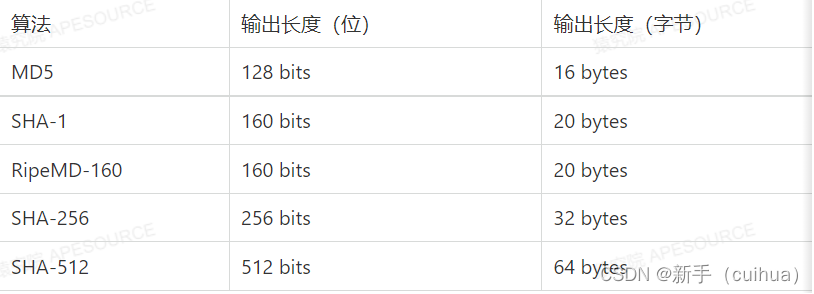一、常见的哈希算法的总结
1.哈希碰撞
(输入两个不同的值得到相同的结果),碰是不能避免的,因为输出的字节长度是固定的,String的hashCode90输出是4字节整数,是有限的。
"AaAaAa".hashCode(); // 0x7460e8c0
"BBAaBB".hashCode(); // 0x7460e8c0
2.常用的哈希算法

1MD5算法
package com.xiaojia;
import java.io.UnsupportedEncodingException;
import java.security.MessageDigest;
import java.security.NoSuchAlgorithmException;
public class Test {
public static void main(String[] args) throws NoSuchAlgorithmException, UnsupportedEncodingException {
//创建一个MessageDigest实例
MessageDigest ch = MessageDigest.getInstance("MD5");
//反复调用update输出数据
ch.update("cui".getBytes("UTF-8"));
ch.update("hua".getBytes("UTF-8"));
byte[] results = ch.digest();
StringBuilder xh = new StringBuilder();
for(byte bite : results) {
xh.append(String.format("%02x", bite));
}
System.out.println(xh.toString());
}
}
1.1MD5算法(加密后的算法转化成字符串)
String password = "123321cuihuabuyaochoule";
try{
MessageDigest message = MessageDigest.getInstance("MD5");
message.update(password.getBytes());
byte[] resultByteArray = message.digest();
StringBuilder result = new StringBUilder();
for(byte bite : resultByteArray){
result.append(String.format("%20x",bite));
}
System.out.println(result);
System.out.println(result.length());
} catch (NoSuchAlgorithmException e) {
e.printStackTrace();
}2SHA-1算法
String password = "123321cuihuabuyaochoule";
String stld = UUID.randUUID().toString().substring(0,6);
System.out.println(stld);
try{
MessageDigest message = MessageDigest.getInstance("SHA-1");
message.update(password.getByte());
message.update(stld.getByte());
byte[] resultByteArray = message.digest();
StringBuilder result = new StringBuilder();
for(byte bite : resultByteArray){
result.append(String.format("%02x",bite));
}
System.out.println(result1);
}catch (NoSuchAlgorithmException e) {
e.printStackTrace();
}3.HmacMD5算法
String password = "cuihua";
try{
KeyGenerator keygen = KeyGenerator.getInstance("HmacMD5");
SecretKey key = keygen.generateKey();
byte[] keyByteArray = key.getEncoded();
StringBUilder KeyStr = new StringBuilder();
for(byte bite : keyByteArray){
KeyStr.append(String.format("%02x",bite));
Mac mac = Mac.getInstance("HmacMD5");
mac.init(key);
mac.update(password.getBytes());
byte[] resultByteArray = mac.doFinal();
StringBuilder resultStr = new BuilderString();
for(byte b : resultByteArray){
resultStr.append(String.format("%02x",b));
}catch (NoSuchAlgorithmException e) {
e.printStackTrace();
}
}总结
哈希算法可以用于验证完整性,具有防篡改功能
常用的哈希算法有MD5,SHA-1等。
2.对称加密算法:
对称加密算法就是传统的用一个密码进行加密和解密,常用的有WinZIP和WinRAR对压缩包的加密和解密。
在软件开发中,常用的堆成加密算法有(密钥的长度直接决定加密强度):

使用AEC加密(比较常见的工作模式是ECB和CBC,密钥长度由算法设计决定,AES的密钥长度是128/192/256位,使用堆成加密算法需要指定算法名称、工作模式、填充模式)
ECB模式
package com.xiao;
import java.security.GeneralSecurityException;
import java.util.Base64;
import javax.crypto.Cipher;
import javax.crypto.NoSuchPaddingException;
import javax.crypto.SecretKey;
import javax.crypto.spec.SecretKeySpec;
public class Morningtwozero1 {
public static void main(String[] args) throws Exception, GeneralSecurityException {
//原文
String message = "Sey baibai";
System.out.println("Message:" + message);
//128位密钥 = 16 bytes Key
byte[] key = "1234567980abcdrf".getBytes();
//加密
byte[] data = message.getBytes();
byte[] encrypted = encrypt(key,data);
System.out.println("Encrypted(加密):" + Base64.getEncoder().
encodeToString(encrypted));
//解密
byte[] decrypted = decrypt(key, encrypted);
System.out.println("Decryted:" + new String(decrypted));
}
//加密
public static byte[] encrypt(byte[] key , byte[] input) throws GeneralSecurityException, NoSuchPaddingException {
//创建密码对象,需要传入算法/工作模式/填充模式
Cipher cipher = Cipher.getInstance("AES/ECB/PKCS5Padding");
//根据key的字节内容,“恢复”密钥对象
SecretKey keySpec = new SecretKeySpec(key, "AES");
//初始化密钥:设置加密模式ENCRYPT_MODE
cipher.init(Cipher.ENCRYPT_MODE, keySpec);
//根据原始内容(字节)进行加密
return cipher.doFinal(input);
}
//解密
public static byte[] decrypt(byte[] key,byte[] input) throws GeneralSecurityException, NoSuchPaddingException {
//创建密码对象,需要传入算法/工作模式./填充模式
Cipher cipher = Cipher.getInstance("AES/ECB/PKCS5Padding");
//根据key的字节内容,“恢复”密钥对象
SecretKey keySpec = new SecretKeySpec(key,"AES");
//初始化密钥,设置解密模式
cipher.init(Cipher.DECRYPT_MODE, keySpec);
//根据原始内容(字节),进行解密
return cipher.doFinal(input);
}
}
步骤:1:根据算法名称/工作模式/填充模式获取Cipher实例
2:根据算法名称初始化一个SecretKey实例,密钥必须是指定长度
3:使用SerectKey初始化Cipher实例,并设置加密或解密模式
4:传入明文或密文,获得密文或明文
CBC模式
package com.xiao;
import java.security.GeneralSecurityException;
import java.security.InvalidAlgorithmParameterException;
import java.security.InvalidKeyException;
import java.security.SecureRandom;
import java.util.Arrays;
import java.util.Base64;
import javax.crypto.BadPaddingException;
import javax.crypto.Cipher;
import javax.crypto.IllegalBlockSizeException;
import javax.crypto.spec.IvParameterSpec;
import javax.crypto.spec.SecretKeySpec;
public class Morningtwozero2 {
public static void main(String[] args) throws GeneralSecurityException, GeneralSecurityException {
String message = "dawd";
System.out.println("Message(原始信息) " + message);
byte[] key = "1234567980abcdrf1234567980abcdrf".getBytes();
byte[] data = message.getBytes();
byte[] encryted = encrypt(key,data);
System.out.println("Encrypted" + Base64.getEncoder().encodeToString(encryted));
//解密
byte[] decrypted = decrypt(key,encryted);
System.out.println("Decrypted" + new String(decrypted));
}
public static byte[] encrypt(byte[] key,byte[] input) throws GeneralSecurityException, InvalidAlgorithmParameterException {
//设置算法/工作模式CBC/填充
Cipher cipher = Cipher.getInstance("AES/CBC/PKCS5Padding");
//恢复密钥对象
SecretKeySpec keySpec = new SecretKeySpec(key, "AES");
//CBC模式需要生成一个16 bytes的initialization vector;
SecureRandom sr = SecureRandom.getInstanceStrong();
byte[] iv = sr.generateSeed(16);//生成16个字节的随机数
System.out.println(Arrays.toString(iv));
IvParameterSpec ivps = new IvParameterSpec(iv);//随机数封装成IvParameterSpec
//初始化密钥:操作模式、密钥、IV参数
cipher.init(Cipher.ENCRYPT_MODE,keySpec, ivps);
//加密
byte[] data = cipher.doFinal(input);
//IV不要用保密,把IBV和密文一起返回
return join(iv,data);
}
//解密
public static byte[] decrypt(byte[] key,byte[] input) throws GeneralSecurityException, BadPaddingException {
//把input分割成OIV和密文
byte[] iv = new byte[16];
byte[] data = new byte[input.length - 16];
System.arraycopy(input, 0, iv, 0, 16);//IV
System.arraycopy(input, 16, data, 0, data.length);//密文
System.out.println(Arrays.toString(iv));
//解密
Cipher cipher = Cipher.getInstance("AES/CBC/PKCS5Padding");
SecretKeySpec keySpec = new SecretKeySpec(key,"AES");
IvParameterSpec ivps = new IvParameterSpec(iv);
//初始化
cipher.init(Cipher.DECRYPT_MODE, keySpec,ivps);
return cipher.doFinal(data);
}
public static byte[] join(byte[] bs1,byte[] bs2) {
byte[] r = new byte[bs1.length + bs2.length];
System.arraycopy(bs1, 0, r, 0, bs1.length);
System.arraycopy(bs2, 0, r, bs1.length, bs2.length);
return r;
}
}
在CBC模式下,需要一个随机生成的16字节IV参数,必须使用SecureRandom生成,
3.非对称加密算法
加密和解密使用的不是相同的密钥,只有同一个公钥-私钥对才能正常加解密
RSA算法它的密钥有256/512/1024/2048/4096等不同的长度。长度越长,密钥强度越大,计算速度也越慢。
RSA算法
import java.math.BigInteger;
import java.security.GeneralSecurityException;
import java.security.KeyPair;
import java.security.KeyPairGenerator;
import java.security.PrivateKey;
import java.security.PublicKey;
import javax.crypto.Cipher;
// RSA
public class Main {
public static void main(String[] args) throws Exception {
// 明文:
byte[] plain = "Hello, encrypt use RSA".getBytes("UTF-8");
// 创建公钥/私钥对:
Human alice = new Human("Alice");
// 用Alice的公钥加密:
// 获取Alice的公钥,并输出
byte[] pk = alice.getPublicKey();
System.out.println(String.format("public key(公钥): %x", new BigInteger(1, pk)));
// 使用公钥加密
byte[] encrypted = alice.encrypt(plain);
System.out.println(String.format("encrypted(加密): %x", new BigInteger(1, encrypted)));
// 用Alice的私钥解密:
// 获取Alice的私钥,并输出
byte[] sk = alice.getPrivateKey();
System.out.println(String.format("private key(私钥): %x", new BigInteger(1, sk)));
// 使用私钥解密
byte[] decrypted = alice.decrypt(encrypted);
System.out.println("decrypted(解密): " + new String(decrypted, "UTF-8"));
}
}
// 用户类
class Human {
// 姓名
String name;
// 私钥:
PrivateKey sk;
// 公钥:
PublicKey pk;
// 构造方法
public Human(String name) throws GeneralSecurityException {
// 初始化姓名
this.name = name;
// 生成公钥/私钥对:
KeyPairGenerator kpGen = KeyPairGenerator.getInstance("RSA");
kpGen.initialize(1024);
KeyPair kp = kpGen.generateKeyPair();
this.sk = kp.getPrivate();
this.pk = kp.getPublic();
}
// 把私钥导出为字节
public byte[] getPrivateKey() {
return this.sk.getEncoded();
}
// 把公钥导出为字节
public byte[] getPublicKey() {
return this.pk.getEncoded();
}
// 用公钥加密:
public byte[] encrypt(byte[] message) throws GeneralSecurityException {
Cipher cipher = Cipher.getInstance("RSA");
cipher.init(Cipher.ENCRYPT_MODE, this.pk); // 使用公钥进行初始化
return cipher.doFinal(message);
}
// 用私钥解密:
public byte[] decrypt(byte[] input) throws GeneralSecurityException {
Cipher cipher = Cipher.getInstance("RSA");
cipher.init(Cipher.DECRYPT_MODE, this.sk); // 使用私钥进行初始化
return cipher.doFinal(input);
}
}




















 138
138











 被折叠的 条评论
为什么被折叠?
被折叠的 条评论
为什么被折叠?








